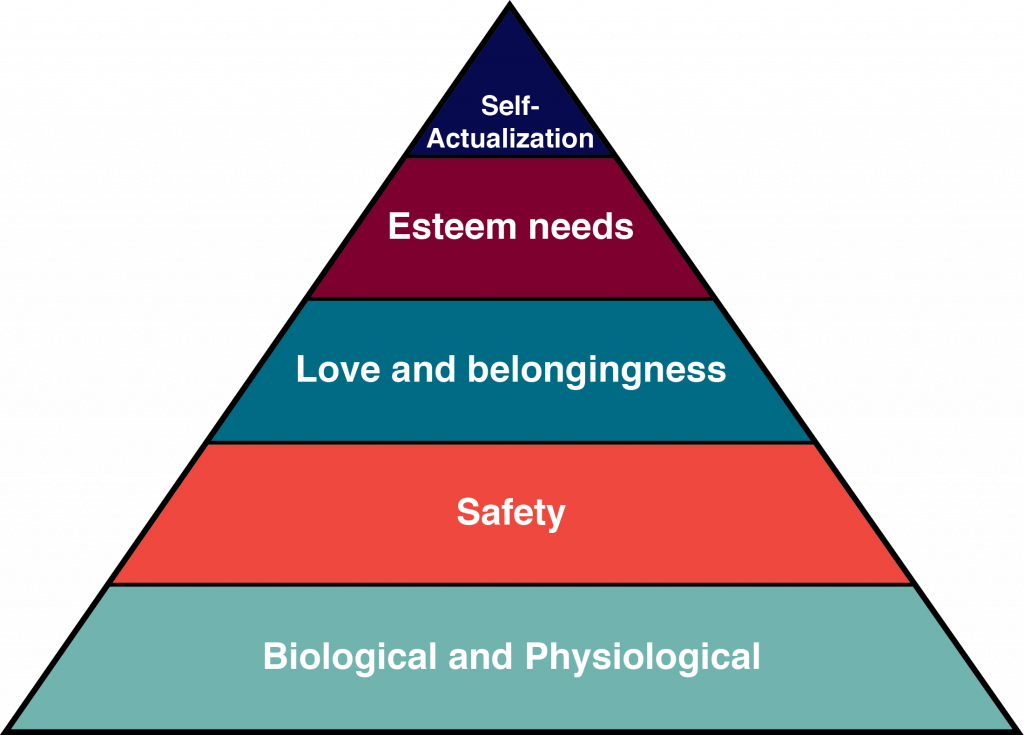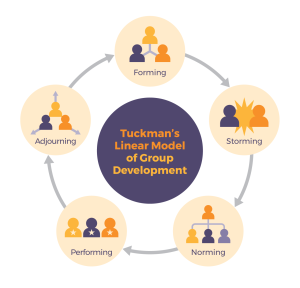13.3. Developing Team
The project team works with the project manager to develop the project management plans, schedule the work of the project, acquire the needed resources, monitor project progress and see the project through to its successful completion. Team members may be devoted solely to working on the management aspects of a project, or may also be performing the work of the project. How well the project team works together will determine the success or failure of a project.
Team Member Motivation
In regard to how project managers may view the motivation of team members, let’s take a look at what motivates individuals, teams, and organizations.
Basic Needs: Maslow’s Hierarchy of Needs
Abraham Maslow provided a model to understand basic human needs which is usually represented as a pyramid (see Figure 13.1). Each need builds on the others: A person’s esteem needs are not that important if they are struggling with meeting the biological need to eat. Here are each of the levels in Maslow’s hierarchy:
- Biological and Physiological: What a person needs to survive, such as food, water, and shelter.
- Safety: The need to be safe in your person, have financial security, and protect against accidents and illness.
- Love and Belongingness: The need to be loved by one’s family and community.
- Esteem: The need to be respected and valued by others.
- Self-Actualization: At the top of the pyramid is the desire to become the best self that you can. For example, working hard to become the best artist, parent, or project manager you can become.

For project managers, this model is useful in several ways. It explains why team members who have problems with their health, family relations or other “lower” needs, will have a problem performing their best on the job. Project managers will also try to meet the esteem needs of their team members by acknowledging their contributions and celebrating successes. This can be an award formally presented at a celebration dinner, or a simple email expressing thanks. Anecdotally, it doesn’t seem that the size or formality of the acknowledgement matters much, what is important is that it is given sincerely.
Understanding Team Development
A number of management professionals and academics have studied project team development. Let’s review the model that PMI considers the most valuable in understanding team development.
Tuckman’s Stages of Team Development

Dr. Bruce Tuckman observed that teams go through a series of developmental stages: Forming, Storming, Norming, Performing, and Adjourning. Each stage has predictable characteristics.
Forming: The group is brought together for the first time. The team is orienting themselves to the task at hand. At this stage, there may be little agreement on how to approach the project and team members may struggle with understanding the purpose of the project. The project manager needs to provide guidance and direction during this stage.
Storming: Team members are trying to figure out their roles in the group. Conflict and power struggles are common, but so is a clearer vision for the group. During this time of intergroup conflict, the project manager needs to provide support and coaching.
Norming: At this stage, the team will have developed a consensus regarding roles, processes and approaches to the work ahead. The project manager should participate by working as a facilitator for the group.
Performing: At this point, the group has a clear vision and purpose and is focused on meeting performance goals, project milestones and other benchmarks. The project manager should be able to delegate more and more responsibility to the team, with less supervision.
Adjourning: Once the project is completed, the team should collect lessons learned and transition to other projects or roles. The project manager should provide recognition of the work done by the team and help them transition to their next project (provide recommendations, etc.)
Fast-Tracking Team Development
Project managers who can quickly move the team from the Forming stage to the Performing stage will have huge advantages in terms of performance. To do this, project managers incorporate team-building activities into the project. Starting the project with some team-building activities will let the team start to form, resolve interpersonal conflicts and develop norms of behaviour in a low-risk environment. Unfortunately, some project managers perceive taking time for team building as a waste of time. However, the time invested here pays off with a much more motivated and better-performing team. There are lots of opportunities to incorporate team-building activities into the planning process. Perhaps the most important process a project manager can facilitate is helping team members learn to trust each other.
“2.1 Team Member Motivation and 2.2 Understanding Team Development” from Project Management Fundamentals by J. Scott Christianson is licensed under a Creative Commons Attribution-NonCommercial-ShareAlike 4.0 licence, except where otherwise noted.

